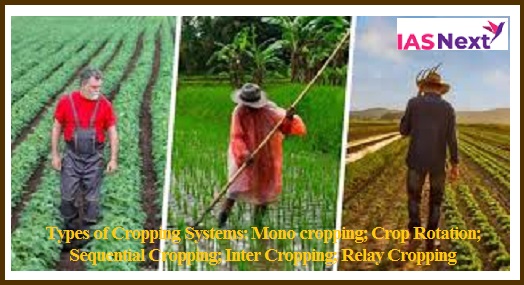CURRENT AFFAIRS
Get the most updated and recent current affair content on Padhaikaro.com
Types of Cropping Systems: Mono cropping; Crop Rotation; Sequential Cropping; Inter Cropping; Relay Cropping
- IAS NEXT, Lucknow
- 07, Jan 2021

Cropping Systems/ Combinations
Monocropping: Example Planting Wheat year after year in the same field. Monocropping is when the field is used to grow only one crop season after season.
Disadvantages: it is difficult to maintain cover on the soil; it encourages pests, diseases and weeds; and it can reduce the soil fertility and damage the soil structure.
Crop Rotation: Example Planting maize one year, and beans the next. Crop Rotation means changing the type of crops grown in the field each season or each year (or changing from crops to fallow).
Crop rotation is a key principle of agriculture conservation because it improves the soil structure and fertility, and because it helps control weeds, pests and diseases.
Sequential Cropping: Example- Planting maize in the long rains, then beans during the short rains. Sequential Cropping involves growing two crops in the same field, one after the other in the same year.
In some places, the rainy season is long enough to grow two crops: either two main crops, or one main crop followed by a cover crop.
Growing Crops two crops may also be possible if there are two rainy seasons, or if there is enough moisture left in the soil to grow a second crop.
Intercropping: Examples- Planting alternating rows of maize and beans, or growing a cover crop in between the cereal rows. Intercropping means growing two or more crops in the same field at the same time.
Mixed Intercropping: Distribution of the seeds of both the crops, or dibbling the seeds without any row arrangement. This process is called mixed intercropping. It is easy to do but makes weeding, fertilization and harvesting difficult. Individual plants may compete with each other because they are too close together.
Planting the main crop in rows and then spreading the seeds of the intercrop (such as a cover crop).
Row Intercropping: Planting both the main crop and the intercrop in rows. This is called row intercropping. The rows make weeding and harvesting easier than with mixed intercropping.
Stir Cropping: Example Planting alternating strips of maize, soybean and finger millet. Stir Cropping involves planting broad strips of several crops in the field. Each strip is 3–9 m wide. On slopes, the strips can be laid out along the contour to prevent erosion. The next year, the farmer can rotate crops by planting each strip with a different crop.
Advantages:
- It produces a variety of crops, the legume improves the soil fertility, and rotation helps reduce pest and weed problems.
- The residues from one strip can be used as soil cover for neighbouring strips.
- At the same time, strip cropping avoids some of the disadvantages of intercropping: managing the single crop within the strip is easy, and competition between the crops is reduced.
Relay Cropping: Example- Planting maize, then sowing beans between the maize rows four weeks later.
Relay Cropping the process of growing one crop, then planting another crop (usually a cover crop) in the same field before harvesting the first. This helps avoid competition between the main crop and the intercrop. It also uses the field for a longer time, since the cover crop usually continues to grow after the main crop is harvested.

(c) Issues related to direct and indirect farm subsidies and minimum support prices
Farm Subsidies in India: Definition; Working; Need; Negative Impacts
Agriculture Subsidies in India
Introduction of the HYV program in the mid-1960s necessitated a high priority to supplying quality inputs like irrigation, water, fertilizers and electricity to the Indian farmers. These all were classified as essential inputs for the development of the agriculture.
To ensure that these inputs are accessible to all farmers at all the times the government decided to subsidised these inputs.
How Subsidy Works

There are two most common ways of subsidising agriculture;
- Firstly, governments may pay much higher prices for the agricultural products than what the farmers can obtain under free market environment, and
- Secondly, by supplying the inputs at a price that is below the cost of supplying these inputs or below at the price that would prevail in an open free trade environment.
- Higher prices for farm products can be provided mainly by insulating the domestic markets from the world economy through a restrictive trade policy.
- On the other hand, vital inputs like fertilisers, irrigation water, credit, electricity used in the agricultural sector can be supplied to the farmers at prices which are below the open market prices. The prices of these inputs, therefore, do not reflect their true value, i.e, the real cost of supplying these inputs.
- Of the above mentioned two alternatives, subsidies on inputs are normally preferred because it is believed that benefits of government expenditure can be derived by the farmers only in proportion to their use of inputs. Input subsidisation also avoids raising food and raw material prices, thus avoiding the plausible adverse effect on growing industrial sector or a large mass of poor living in the developing countries.
- However, most often, it is not just a single mechanism but a combination of both higher output prices and lower input prices which has been used to subsidise agriculture with objectives varying from the need to raise domestic production and protect incomes of the farming community.
- India also tinkered with both input and output prices, primarily to protect the poor and/or to stimulate the use of modern inputs.
Rationale for subsidising Agriculture

Negative Impacts of Agriculture Subsidies

However, the issue of agriculture subsidies is not to be examined only from the perspective of fiscal imbalances, but from a much wider perspective of ensuring food and nutritional security for Billions and ensuring that poor and marginal farmers do not get wiped out from the market.
Direct and Indirect Farm Subsidies
